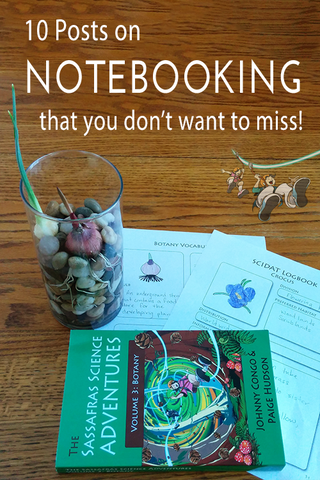FREE Shipping on all our products! (Please Note: Orders may experience a delay of a week or more in shipping due to the high volume of orders at this time of year.)
FREE Shipping on all our products! (Please Note: Orders may experience a delay of a week or more in shipping due to the high volume of orders at this time of year.)
10 Posts On Notebooking That You Don’t Want To Miss
April 22, 2024 3 min read
Nowadays, Blaine and Tracey love notebooking! They think it's so much better than those boring worksheets they used to have to do.
Paige has shared about the basics of notebooking before, but here's a quick recap:
"Notebooking is a method of interacting with and recording the information that students are learning. At its core, notebooking has two key components - material content and a visual component. Both are equally important since they each engage different parts of the students’ brains."
Let's dive into ten posts that will help you on your notebooking journey!
10 Posts On Notebooking

#1 - Should I correct errors on notebooking pages?
The Notebooking Fairy answers a common question about notebooking in this post. She says:
"You don’t want to nit-pick. But you want to have certain standards of excellence."
The rest of the article is filled with great tips for how and when to point out errors while notebooking.
#2 - 5 Ways to Use Notebooking in Middle and High School
Think that notebooking is only for the elementary years? Think again! Marcy at Ben and Me shares her top 5 reasons for using notebooking during the middle and high school years. She says:
"In middle school, notebooking proved to benefit {her son} many ways — some I expected based on our experience with lapbooking — but also in ways I had not initially expected or planned for."
#3 - Is notebooking right for your child?
Danika from Thinking Kids helps you to determine if notebooking is right for you and inspires you to give notebooking a try through learning about some famous notebookers. She says:
"There are a lot of fads in education. However, notebooking has existed for a long time and been used by many successful, creative adults."
#4 - Notebooking 101
All the basics of notebooking are wrapped up into this post from Jamie at the Unlikely Homeschooler. She says:
"In its simplest form, notebooking is just journaling. It is a tool to compile and organize the written thoughts, opinions, discoveries, and experiences of an individual."
#5 - Lapbooking vs. Notebooking
Paige explains what lapbooks and notebooks are and helps you to see which will work best for your students. She says:
"Both lapbooks and notebooks have a place in my teacher toolbox."
#6 - 3 Easy Steps for Getting Started with Notebooking
How do you get started with notebooking? These three easy steps will get you on the right path! Paige says:
"The best way to get started with notebooking is to learn more about it, to decide what you want to notebook about, and then try it out."
#7 - Why Choose Notebooking over Worksheets?
Worksheets have been a part of the education scene for years, so why use notebooking instead? This post will help you answer that question. In it, Paige says:
"I still appreciate worksheets as they have their place, but I have fallen in love with notebooking. I now understand how valuable it is to have a student narrate rather than respond with expected facts."
#8 - How to Use Notebooking with Different Ages
Notebooking can be used from preschool all the way up! In this post, Paige shares how you can tailor notebooking for the different ages. She says:
"Throughout the years, notebooking is a beneficial way to document what your students have learned in a way that is meaningful to them."
#9 - 7 Organizational Tips for Notebooking
Your notebooking pages can get out of control! These seven tips will help you organize your notebooks. Here's a look at one of those tips:
"Keep a file folder for each subject and place the papers in there in order throughout the year. Then, hole-punch and file as you have time."
#10 - 3 Content Related Tips for Notebooking
Figuring out what to put on your notebooking pages is another common struggle with notebooking. These three tips will help with that. Here's a look at one of those tips:
"I always recommend discussing what the students read before asking for the narrations that you will serve as the material component of their notebooking pages."
A Final Word
We trust that these ten posts will help you as you wield the tool of notebooking in your homeschool! Want to see a living books curriculum that uses notebooking? Here you go!
Also in Elemental Science Blog
How can we use one experiment for multiple ages?
June 06, 2025 4 min read

Is it possible to do only one experiment for homeschool science each week with multiple kids? Yes, but it will take some work. Click to get tips on how.
All About Experiment Variables for Hands-on Science and Science Fair Projects
April 12, 2025 2 min read

What variables are found in an experiment? And how can you know which is which? Click "Read More" to get the answers.
4 Easy Steps to Add Current Events into your Homeschool Science Plan
November 02, 2024 3 min read

Adding a current events study to a subject can increase the student’s interest as well as inform him or her of the latest advances in the field. Having a student read a relevant article or two each month will enhance what he or she is learning in a subject.
This month, I wanted to share with you all how to incorporate the latest scientific news into your studies.
Subscribe
Sign up to get the latest on sales, new releases and more …

